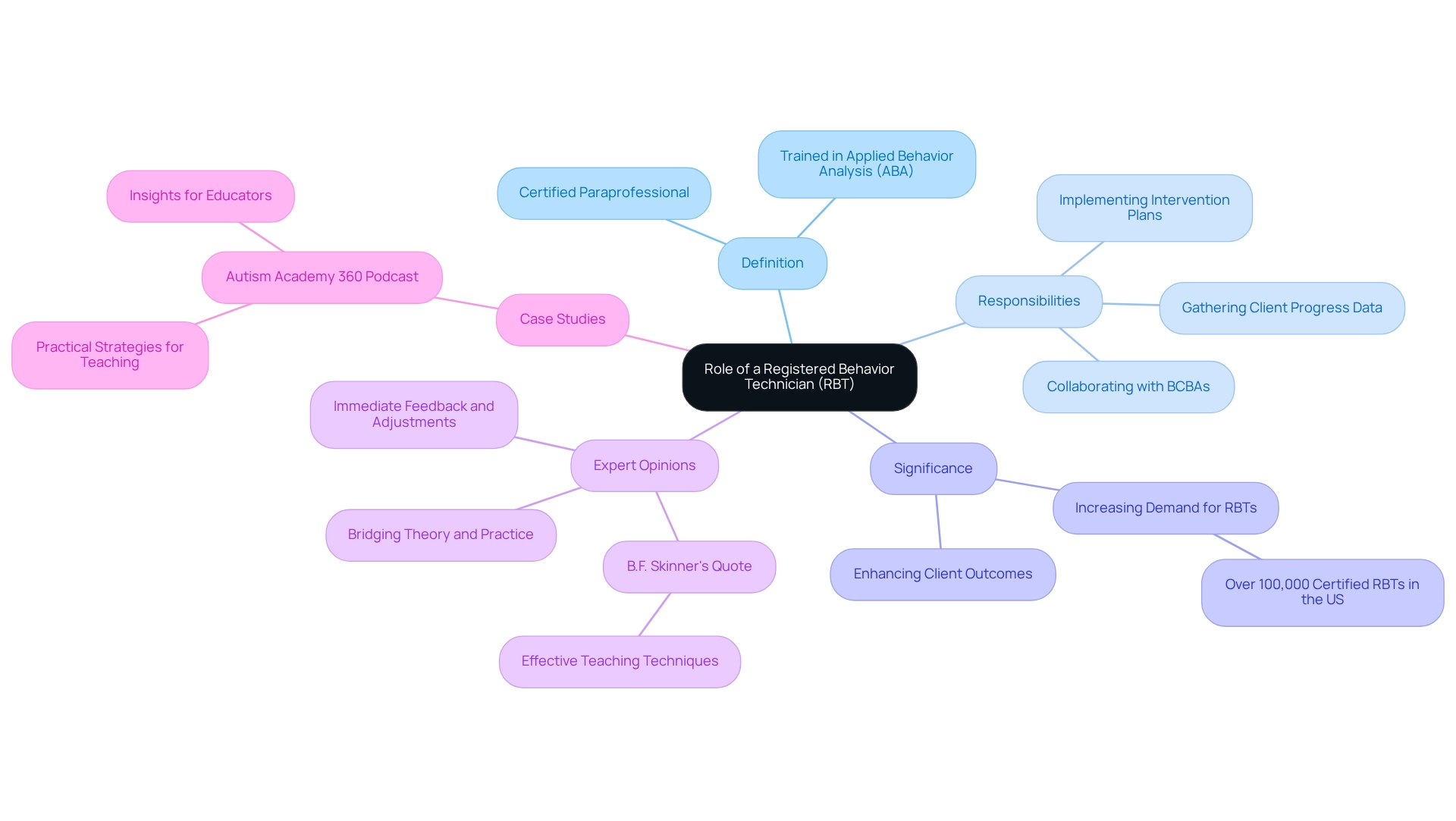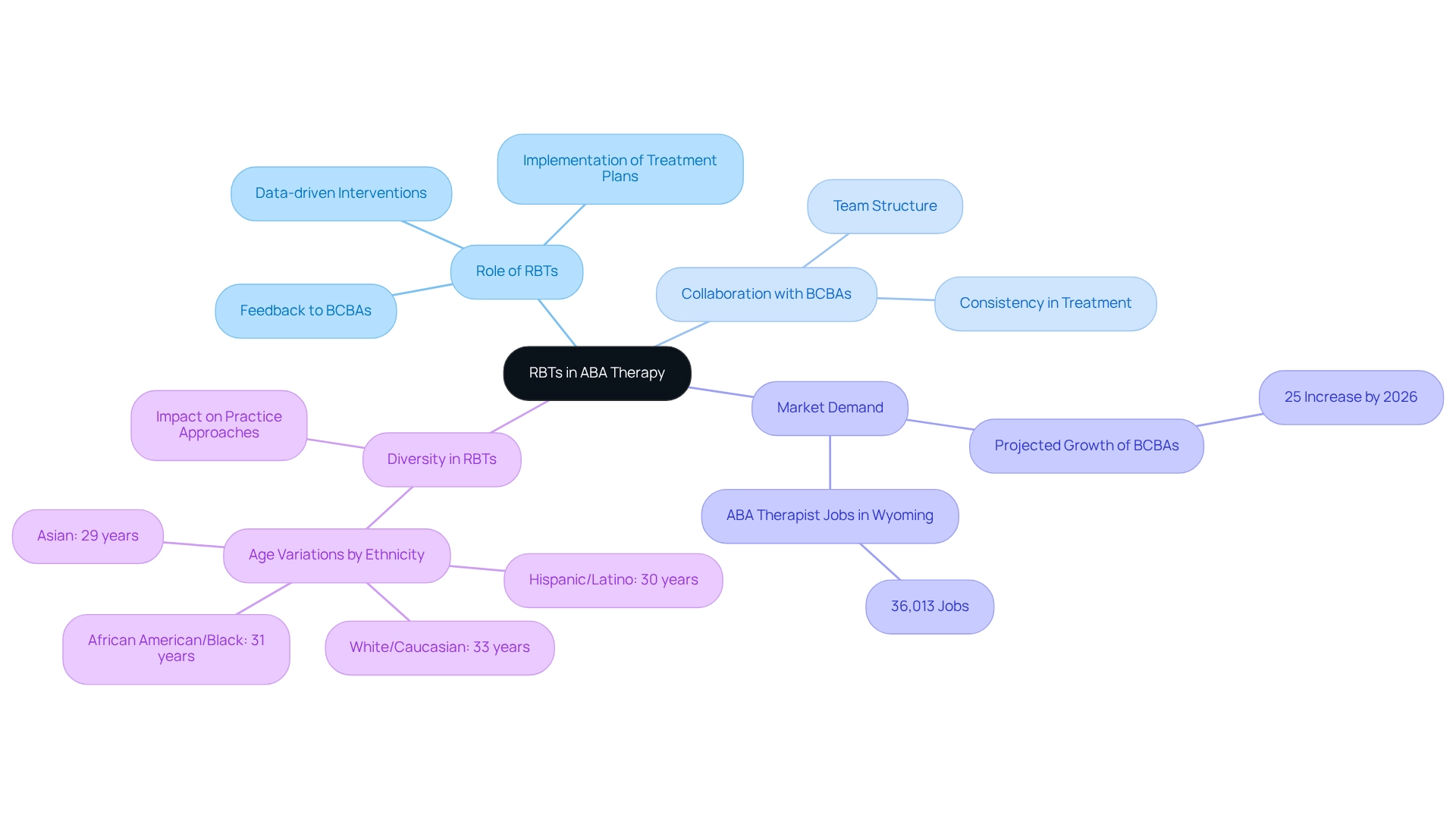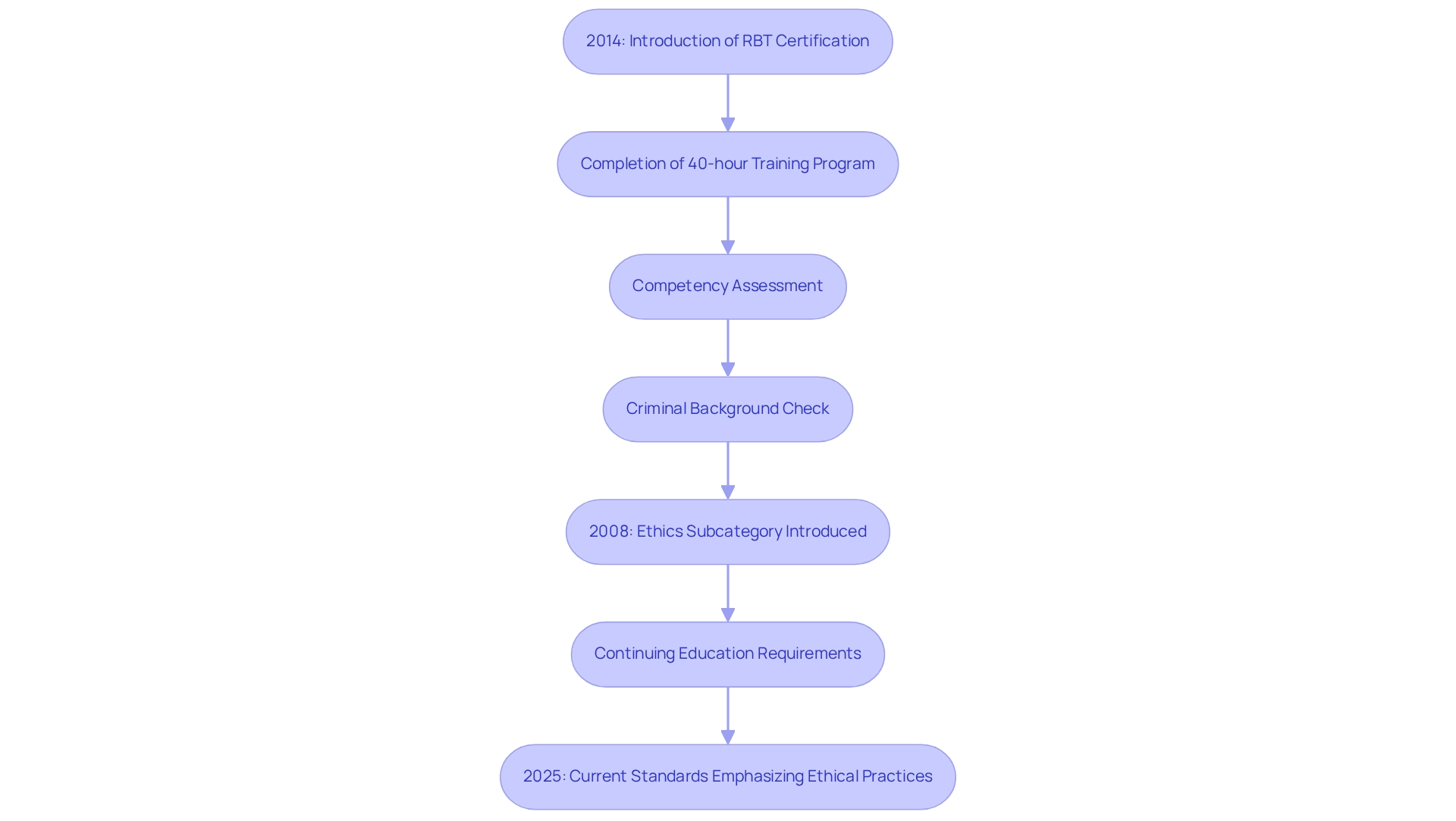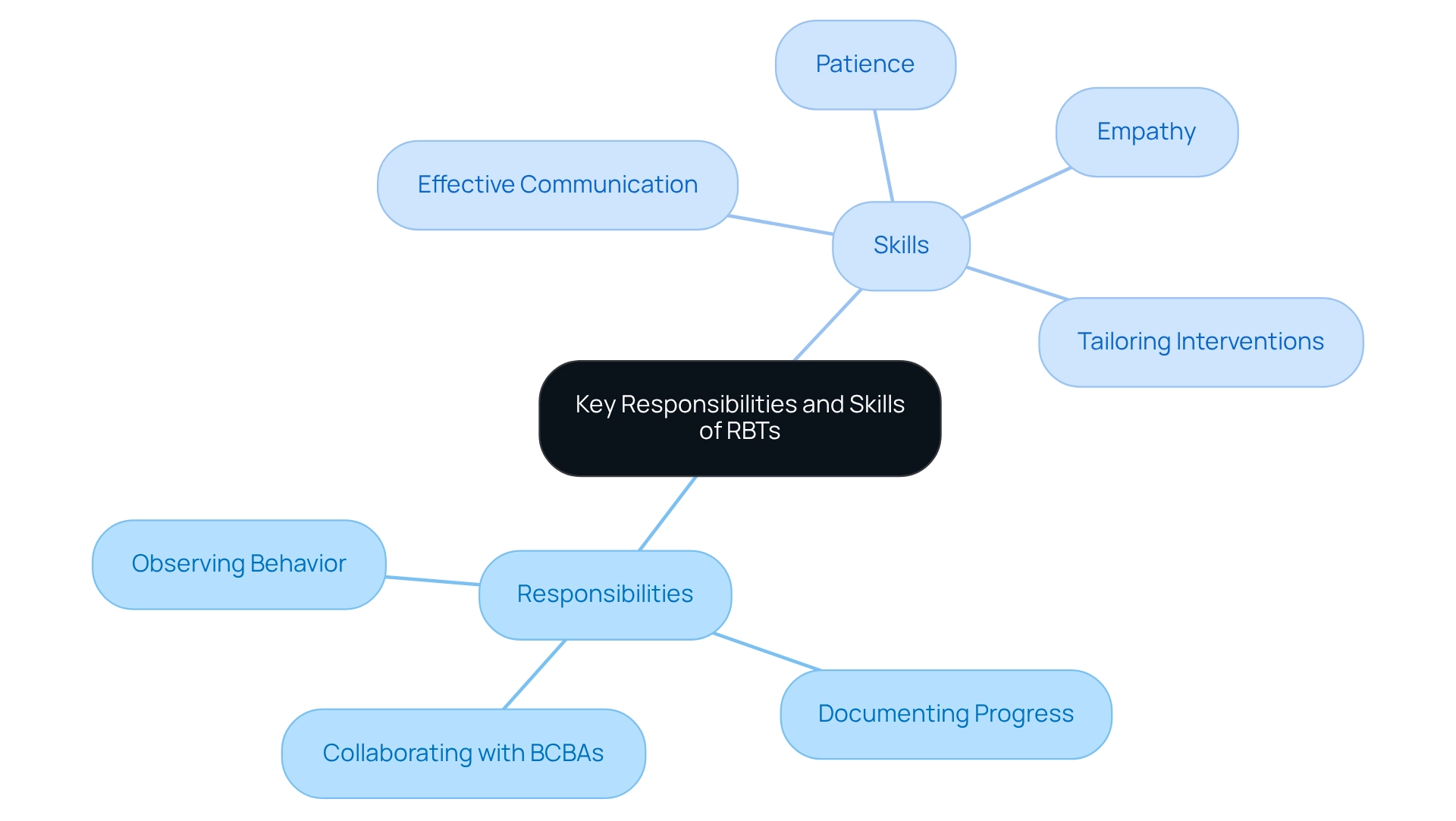June 1, 2025

The role of a Registered Behavior Technician (RBT) in ABA therapy is critical. RBTs implement behavior intervention plans and provide direct services to clients, particularly those with autism and other developmental disabilities, all under the supervision of Board Certified Behavior Analysts (BCBAs).
The demand for qualified professionals in this field is growing, making RBTs essential for the success of ABA therapy. They actively engage with clients, gather data on progress, and collaborate with BCBAs to refine treatment strategies. This collaboration not only enhances client outcomes but also addresses the increasing need for expertise in behavioral health.
As healthcare employers, are you facing challenges in hiring qualified RBTs? Consider how platforms like Hire ABA can streamline your recruitment process, ensuring you have the right professionals to meet your clients' needs. Trust in reliable recruitment solutions to bolster your team and improve service delivery.
In the dynamic landscape of Applied Behavior Analysis (ABA), the role of Registered Behavior Technicians (RBTs) has become increasingly vital. These certified paraprofessionals are not merely tasked with executing behavior intervention plans; they serve as a crucial link between theoretical concepts and their practical application.
With the demand for RBTs on the rise, driven by their proven impact on client outcomes, it is essential to understand their roles, responsibilities, and the evolution of their certification. This article explores the multifaceted contributions of RBTs, detailing their essential skills and the context of their work within ABA therapy.
By illuminating the standards that govern their practice, we underscore the critical role they play in enhancing the lives of individuals with developmental disabilities.
Are you aware of how RBTs can transform the therapeutic process? As we delve into their contributions, consider how understanding their impact can lead to improved outcomes in your practice.
To understand what's an RBT, it's important to know that a Registered Behavior Technician (RBT) is a certified paraprofessional specifically trained in Applied Behavior Analysis (ABA). Under the supervision of Board Certified Behavior Analysts (BCBAs), what's an RBT plays a crucial role in implementing behavior intervention plans and providing direct services to clients, particularly those with autism and other developmental disabilities. Their hands-on involvement is essential for the success of ABA therapy, as they actively engage with clients to promote learning and behavioral improvements through structured interventions.
In 2025, the significance of , commonly referred to as what's an RBT, in the field of ABA is underscored by the escalating demand for qualified professionals, with the number of certified individuals in the United States exceeding 100,000. This growth reflects the increasing recognition of their role in enhancing client outcomes. RBTs are responsible for executing treatment plans, gathering information on client progress, and collaborating with Board Certified Behavior Analysts to adjust strategies as needed.
Expert opinions highlight that registered behavior technicians, often referred to as what's an RBT, are vital in bridging theoretical knowledge with practical application in ABA therapy. Their direct interaction with clients facilitates immediate feedback and adjustments, which are critical for effective behavior change. As noted in recent discussions, understanding the function of behavior is fundamental to implementing successful interventions, which highlights what's an RBT's role in this process.
As B.F. Skinner, the Father of Applied Behavior Analysis, stated, "Teachers must learn how to teach ... they need only to be taught more effective ways of teaching." This quote emphasizes the importance of effective teaching techniques in ABA, particularly concerning what's an RBT and their role.
Case studies, such as those featured in the Autism Academy 360 Podcast, illustrate how registered behavior technicians apply practical strategies to support students with autism, demonstrating their impact on educational settings. The podcast provides valuable insights into the strategies employed by RBTs, addressing the question of what's an RBT and reinforcing their necessity in delivering high-quality ABA services and ultimately leading to improved outcomes for clients.

In the realm of Applied Behavior Analysis (ABA), a key question is often what's an RBT and their increasingly recognized pivotal role within intervention teams. Collaborating closely with (BCBAs), RBTs execute treatment plans designed to enhance clients' behavioral outcomes. Trained to implement data-driven interventions, they gather and analyze data while providing essential feedback to BCBAs, ensuring treatment consistency and efficacy. This role is particularly crucial across diverse environments such as schools, clinics, and home settings, where ABA interventions can profoundly impact the lives of children and their families.
By 2025, [the contributions of Registered Behavior Technicians to the success of ABA intervention teams](https://apricott.com/resources/aba-therapy-statistics) are gaining wider acknowledgment. A significant proportion of these teams now integrates RBTs into their structure, reflecting the rising demand for these professionals. This demand mirrors the overall growth in , projected to see a 25% increase in the need for BCBAs by 2026. Such growth underscores the expanding job market for ABA professionals. Notably, a recent case study revealed age variations among ABA therapists, indicating that the average age of RBTs differs by ethnicity, potentially influencing their approaches and perspectives in practice. This diversity enriches the therapeutic process, fostering a more inclusive environment for clients.
The effectiveness of RBTs in implementing ABA treatment plans is underscored by their direct involvement in behavioral interventions, which are essential for achieving positive outcomes. Their hands-on approach not only facilitates immediate strategy implementation but also contributes to the long-term success of clients in managing their behaviors. As the demand for ABA therapy continues to rise, the role of Registered Behavior Technicians will remain crucial in shaping the future of behavioral health services.
Are you facing challenges in hiring qualified professionals for your ABA team? Consider how Hire ABA can streamline your recruitment process, ensuring you find the right talent to meet your needs, and you might wonder, what's an RBT? With the growing importance of RBTs in the field, now is the time to act and secure the expertise necessary for successful interventions.

The Registered Behavior Technician (RBT) certification, introduced by (BACB) in 2014, helps to answer the question, what's an RBT, by addressing the growing demand for qualified paraprofessionals in Applied Behavior Analysis (ABA). This certification process necessitates the completion of a 40-hour training program, a competency assessment, and a criminal background check, ensuring that registered behavior technicians possess the essential skills and knowledge for effective practice.
Since its inception, the standards for RBT certification have evolved significantly, leading many to ask, 'what's an RBT' and highlighting the critical role registered behavior technicians play in delivering high-quality ABA services. This evolution is fueled by the BACB's commitment to fostering trust and professionalism within the field, as evidenced by the BACB's 2008 decision to institute an ethics subcategory in its continuing education requirements. This mandates that BCBAs and BCaBAs complete 4 hours of ethics every 2 years.
The BACB's ethics codes, utilized by nearly half of U.S. licensure programs, serve as a foundation for ethical practice, guiding behavior analysts in their professional conduct and informing disciplinary actions. As of 2025, the current standards for RBT certification, which address what's an RBT, emphasize the importance of consistent training and adherence to ethical practices, ultimately enhancing the quality of services provided in ABA therapy.
Dr. Jon Bailey, Chair of the revision workgroup, remarked that the BACB’s evolving ethics-related documents have been pivotal in establishing ethics standards, guiding ethical decision-making, and serving as a basis for disciplinary action. Furthermore, a case study titled "Impact of BACB's Ethics Codes on Professional Standards" illustrates how these codes have laid a foundation for ethical practice, guiding behavior analysts in their professional conduct.

Certified Technicians are integral to the implementation of intervention strategies, focusing on enhancing clients' independence and communication skills, particularly in children with Autism Spectrum Disorder (ASD). Their primary responsibilities include:
As we approach 2025, it's important to understand what's an RBT, as will need to adapt to the evolving landscape of [ABA therapy](https://hireaba.today), which demands ongoing professional development to stay abreast of the latest research and methodologies in the field.
When considering essential competencies for [Registered Behavior Technicians](https://hireaba.today), or RBTs, it's important to understand that these include:
Proficiency in data collection techniques is vital, as behavior technicians must analyze data to inform treatment adjustments. A case study on ABA interventions for diverse needs illustrates this adaptability, showcasing how registered behavior technicians can address challenging behaviors not only in children with autism but also in adults with developmental disabilities or brain injuries. This versatility underscores the broad applicability of ABA techniques across various age groups and situations, emphasizing what’s an RBT and the significant impact registered behavior technicians have on treatment outcomes. As noted by the apricoott team, "ABA therapy can be used to teach a variety of skills, including communication, social, self-help, and academic skills," further underscoring the critical skills that RBTs help cultivate in their clients.

Registered Behavior Technicians (RBTs) play a vital role in Applied Behavior Analysis (ABA), acting as essential links between theory and practice. With over 100,000 certified RBTs in the United States by 2025, their increasing demand underscores their significant contributions to improving client outcomes, especially for individuals with autism and other developmental disabilities.
RBTs collaborate closely with Board Certified Behavior Analysts (BCBAs) to implement and adapt treatment plans based on data-driven insights. Their responsibilities include:
All of which are crucial for fostering long-term behavioral improvements and enhancing clients' communication and independence.
The evolution of RBT certification and standards demonstrates a commitment to ethical practice and professionalism in the field. The rigorous certification process ensures RBTs possess the necessary skills and knowledge for effective practice. As ABA therapy continues to evolve, ongoing professional development will be essential for RBTs to stay current with new research and techniques.
Recognizing the multifaceted contributions of RBTs is critical for anyone involved in ABA therapy. Their impactful work not only enhances therapeutic processes but also leads to better outcomes for clients. As the demand for qualified professionals grows, supporting RBTs will be key to advancing ABA practices and enriching the lives of individuals with developmental challenges.
What is a Registered Behavior Technician (RBT)?
A Registered Behavior Technician (RBT) is a certified paraprofessional trained in Applied Behavior Analysis (ABA) who implements behavior intervention plans and provides direct services to clients, particularly those with autism and other developmental disabilities, under the supervision of Board Certified Behavior Analysts (BCBAs).
What are the responsibilities of an RBT?
RBTs are responsible for executing treatment plans, gathering information on client progress, and collaborating with BCBAs to adjust strategies as needed. They play a crucial role in the hands-on implementation of ABA therapy.
Why is the role of RBTs significant in the field of ABA?
The role of RBTs is significant due to the increasing demand for qualified professionals in ABA, with over 100,000 certified individuals in the U.S. Their involvement is essential for enhancing client outcomes through direct interaction and immediate feedback.
How do RBTs contribute to behavior change?
RBTs facilitate immediate feedback and adjustments during therapy sessions, which are critical for effective behavior change. Their direct engagement with clients helps implement successful interventions based on the understanding of behavior.
What insights can be gained from case studies involving RBTs?
Case studies, such as those featured in the Autism Academy 360 Podcast, illustrate how RBTs apply practical strategies to support students with autism, highlighting their impact on educational settings and the delivery of high-quality ABA services.
How does B.F. Skinner's quote relate to the role of RBTs?
B.F. Skinner's quote emphasizes the importance of effective teaching techniques in ABA, underscoring that RBTs need to be equipped with effective strategies to teach and implement behavior interventions successfully.
Our expert recruitment strategies and AI-driven sourcing ensure that you receive top-notch candidates quickly, without compromising on quality. Whether you’re looking for BCBAs, Clinical Directors, or RBTs, we’ve got you covered.